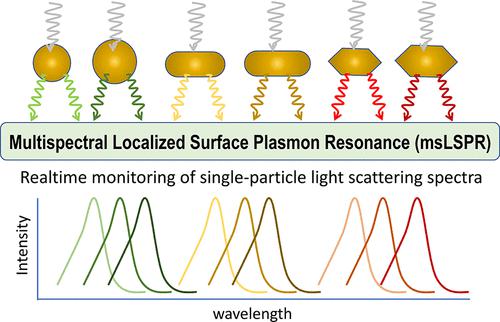Our official English website, www.x-mol.net, welcomes your
feedback! (Note: you will need to create a separate account there.)
Multispectral Localized Surface Plasmon Resonance (msLSPR) Reveals and Overcomes Spectral and Sensing Heterogeneities of Single Gold Nanoparticles
ACS Nano ( IF 15.8 ) Pub Date : 2023-01-19 , DOI: 10.1021/acsnano.2c08702 Stephen Palani 1, 2 , John P Kenison 1 , Sinan Sabuncu 1 , Tao Huang 2 , Fehmi Civitci 1 , Sadik Esener 1, 2 , Xiaolin Nan 1, 2
ACS Nano ( IF 15.8 ) Pub Date : 2023-01-19 , DOI: 10.1021/acsnano.2c08702 Stephen Palani 1, 2 , John P Kenison 1 , Sinan Sabuncu 1 , Tao Huang 2 , Fehmi Civitci 1 , Sadik Esener 1, 2 , Xiaolin Nan 1, 2
Affiliation

|
Metal nanoparticles can be sensitive molecular sensors due to enhanced absorption and scattering of light near a localized surface plasmon resonance (LSPR). Variations in both intrinsic properties such as the geometry and extrinsic properties such as the environment can cause heterogeneity in nanoparticle LSPR and impact the overall sensing responses. To date, however, few studies have examined LSPR and sensing heterogeneities, due to technical challenges in obtaining the full LSPR spectra of individual nanoparticles in dynamic assays. Here, we report multispectral LSPR (msLSPR), a wide-field imaging technique for real-time spectral monitoring of light scattering from individual nanoparticles across the whole field of view (FOV) at ∼0.5 nm spectral and ∼100 ms temporal resolutions. Using msLSPR, we studied the spectral and sensing properties of gold nanoparticles commonly used in LSPR assays, including spheres, rods, and bipyramids. Complemented with electron microscopy imaging, msLSPR analysis revealed that all classes of gold nanoparticles exhibited variations in LSPR peak wavelengths that largely paralleled variations in morphology. Compared with the rods and spheres, gold nanobipyramids exhibited both more uniform and stronger sensing responses as long as the bipyramids are structurally intact. Simulations incorporating the experimental LSPR properties demonstrate the negative impact of spectral heterogeneity on the overall performance of conventional, intensity-based LSPR assays and the ability of msLSPR in overcoming both particle heterogeneity and measurement noise. These results highlight the importance of spectral heterogeneity in LSPR-based sensors and the potential advantage of performing LSPR assays in the spectral domain.
中文翻译:

多光谱局域表面等离子共振 (msLSPR) 揭示并克服单金纳米粒子的光谱和传感异质性
由于局域表面等离子体共振 (LSPR) 附近的光吸收和散射增强,金属纳米颗粒可以成为敏感的分子传感器。几何形状等内在属性和环境等外在属性的变化可能会导致纳米颗粒局域表面等离子体共振的异质性,并影响整体传感响应。然而,迄今为止,由于在动态分析中获得单个纳米粒子的完整 LSPR 光谱的技术挑战,迄今为止,很少有研究检查 LSPR 和传感异质性。在这里,我们报告了多光谱LSPR(msLSPR),这是一种宽视场成像技术,用于以〜0.5 nm光谱和〜100 ms时间分辨率实时光谱监测整个视场(FOV)中单个纳米粒子的光散射。使用 msLSPR,我们研究了 LSPR 测定中常用的金纳米颗粒(包括球体、棒状和双锥体)的光谱和传感特性。辅以电子显微镜成像,msLSPR 分析显示,所有类别的金纳米粒子都表现出 LSPR 峰值波长的变化,这些变化在很大程度上与形态的变化平行。与棒状和球状相比,只要双锥体结构完整,金纳米双锥体就会表现出更均匀、更强的传感响应。结合实验性 LSPR 特性的模拟证明了光谱异质性对传统基于强度的 LSPR 测定的整体性能的负面影响,以及 msLSPR 克服粒子异质性和测量噪声的能力。这些结果凸显了基于 LSPR 的传感器中光谱异质性的重要性以及在光谱域中进行 LSPR 测定的潜在优势。
更新日期:2023-01-19
中文翻译:

多光谱局域表面等离子共振 (msLSPR) 揭示并克服单金纳米粒子的光谱和传感异质性
由于局域表面等离子体共振 (LSPR) 附近的光吸收和散射增强,金属纳米颗粒可以成为敏感的分子传感器。几何形状等内在属性和环境等外在属性的变化可能会导致纳米颗粒局域表面等离子体共振的异质性,并影响整体传感响应。然而,迄今为止,由于在动态分析中获得单个纳米粒子的完整 LSPR 光谱的技术挑战,迄今为止,很少有研究检查 LSPR 和传感异质性。在这里,我们报告了多光谱LSPR(msLSPR),这是一种宽视场成像技术,用于以〜0.5 nm光谱和〜100 ms时间分辨率实时光谱监测整个视场(FOV)中单个纳米粒子的光散射。使用 msLSPR,我们研究了 LSPR 测定中常用的金纳米颗粒(包括球体、棒状和双锥体)的光谱和传感特性。辅以电子显微镜成像,msLSPR 分析显示,所有类别的金纳米粒子都表现出 LSPR 峰值波长的变化,这些变化在很大程度上与形态的变化平行。与棒状和球状相比,只要双锥体结构完整,金纳米双锥体就会表现出更均匀、更强的传感响应。结合实验性 LSPR 特性的模拟证明了光谱异质性对传统基于强度的 LSPR 测定的整体性能的负面影响,以及 msLSPR 克服粒子异质性和测量噪声的能力。这些结果凸显了基于 LSPR 的传感器中光谱异质性的重要性以及在光谱域中进行 LSPR 测定的潜在优势。






























 京公网安备 11010802027423号
京公网安备 11010802027423号